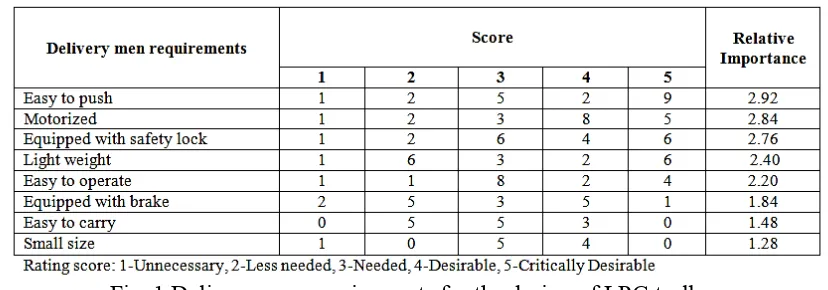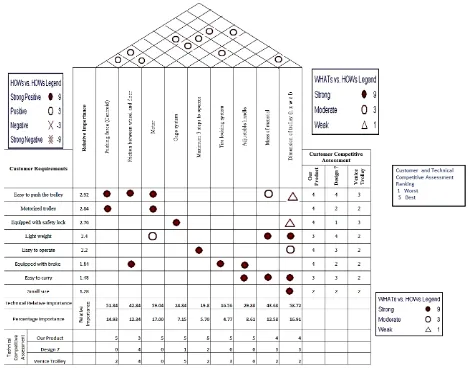Application of Quality Function Deployment to Design a Liquefied
Petroleum Gas Trolley
Al Amin M.S.
a, Isa H.
b, Febrian I.
c, Taufik
d, Nuradilah Z.
eand Nor A.M.
fUniversiti Teknikal Malaysia Melaka (UTeM), Hang Tuah Jaya, 76100, Durian Tunggal, Melaka, Malaysia
a[email protected], b[email protected], c[email protected], d[email protected],
e[email protected], f[email protected]
Keywords: Liquefied petroleum gas (LPG), Quality function deployment (QFD), House of quality (HOQ), Design of LPG cylinder trolley
Abstract. In Malaysia, the liquefied petroleum gas (LPG) is widely used for domestic purposes. The delivery men who are in charge of delivering the LPG cylinders to the customers are exposed to the ergonomic risk factors associated with excessive force due to the heavy steel cylinders. There are devices used to assist the delivery task, however, the devices are not efficient to be used in non-elevated apartments. Due to this reason, this study aims to design an LPG cylinder trolley. Quality Function Deployment was integrated to design the LPG cylinder trolley, so that it can fulfill the delivery man's requirements, thus, an effective device to assist the delivery task is produced. Based on the findings, it can be concluded that the integration of QFD is an effective solution in designing an effective LPG cylinder trolley.
Introduction
Usually the liquefied petroleum gas (LPG) cylinder is widely used for domestic purposes, such as for cooking. The filled LPG cylinder used in households weighs between 30 kg to 34 kg. Meanwhile, the mass of an empty LPG cylinder is from 16 kg to 20 kg. The diameter of the LPG cylinder is 33 cm, and its height is 61 cm. The LPG cylinder is made of steel to keep high pressure gas [1,2]. The LPG cylinder delivery service is highly required in Malaysia. The service of delivering LPG cylinder requires the delivery men to replace the empty cylinder with the filled LPG cylinder. The delivery men usually handle the delivery process manually, such as lifting the filled cylinder from the transporter and sending it to the customer’s place. After replacing the filled cylinder, the delivery man needs to bring back the empty cylinder to the transporter. In the case of non-elevator apartments, the delivery men have to lift and hold the LPG cylinder to transfer it from the ground level to the upper level using the stairs.
Based on the above mentioned LPG cylinder delivery process, the delivery men are exposed to ergonomics risk factors associated with excessive force that may lead to musculoskeletal disorders, such as back and shoulder injuries. The occupational safety and health statistic reported that 36% of workers suffered from back pain, and 13% of workers experienced shoulder injury, which are caused by overexertion and bodily reaction and contact with objects or equipment [3]. Besides, it is reported that 223 cases of overexertion involved in holding and carrying task [4]. The most immediate and useful solution to reduce the risk of injuries among the delivery men is by using trolleys and carts, which can avoid the need for carrying loads over distances [5]. Nevertheless, previous research found that the existing manual materials handling devices do not overcome the problem of mishandling the task due to little attention paid to ergonomics aspects in the design of the trolleys and carts [5,6].
As a solution for this problem, this study aims to design a LPG trolley using the QFD approach. The Quality Function Deployment is one of the planning tools that is used to ensure the delivery men requirements can be satisfied and translated throughout the product design, engineering, and
production [7]. Specifically, this study determines the design feature requirements from the delivery men regarding the LPG trolley.
Methodology
This study performed three stages of work to design the LPG trolley. Stage 1 concerns with determining the delivery men requirement with regard to the design of the LPG trolley. In this stage, a questionnaire was developed and distributed to25 delivery men. The questionnaire was divided into five sections: 1) personal details of the delivery men, 2) operation and job description, 3) operational constraints and health problems, 4) safety issues on current operation, and 5) improvements needed for future design of the LPG trolley. The process of developing the questionnaire and its reliability measurement has been described in the recent publication [9].
The information gathered from the questionnaire leads to Stage 2, which is the development of the LPG trolley specification. In this stage, the design feature requirements from the delivery men were translated into the technical specification using the House of Quality (HoQ). There were 6 steps applied in building the HoQ: 1) listing the design feature requirements from the delivery men (WHAT), 2) listing the technical descriptors (HOW), 3) building the relationship between WHAT and HOW, 4) building the roof known as correlation matrix, 5) analysing customer competitive assessment, and 6) determining the prioritized technical descriptor [7].
The design features required by the delivery men are listed in WHAT of the HoQ. The requirements need to be classified and quantified into a quantitative presentation to obtain the importance ratings of the customer (delivery men) needs. The relative importance of the customer requirement is usually expressed as a set of ratings that is determined through the customer perceptions of those requirements and average of the perceptions. For example, to calculate the relative importance for the delivery men requirement “easy to push”: (1*1) + (2*2) + (5*6) + (2*4) + (9*5) = 73. Hence, the relative importance = 73 / 25 (number of delivery men) = 2.92 (Table 1).The technical descriptors with the highest value of the absolute weight are identified as the most needed to fulfil customer requirements and need improvement [7]. As an example, to obtain the technical relative importance for technical specification “motor” in Figure 2: (2.92*1) + (2.76*1) + (2.40*9) + (2.2*3) + (1.48*9) + (1.28*9) = 58.72.
Results and Discussion
Structured interviews using the questionnaire were conducted with25 delivery men who were directly involved in transporting the LPG cylinder to the customer. The average age of the delivery men was 33 years; all have experiences in delivering the LPG cylinder to non-elevator apartment. It was reported that the delivery men delivered about 21 LPG cylinders to the customers with the frequency of 13 times per day. Out of 25 delivery men, 68% expressed that the existing method (without the use of an assistive device) to transport the LPG cylinder is easy as they have large degree of freedom in their movement. The injuries experienced by the delivery men while transporting the LPG cylinder were also investigated. Of all the delivery men, 92% experienced discomfort in the lower back, 84% and 80% felt discomfort in the neck and upper back respectively. Meanwhile, 60% of the delivery men claimed discomfort in the right shoulder, 8% in the left shoulder and 28% of them experienced discomfort in both shoulders. The reason to the discomfort in their body parts is due to lifting and holding the LPG cylinders. In fact, 60% of the delivery men had involved in accidents while handling the LPG cylinders. Out of which, 36% and 32% of them experienced slip and fall respectively.
Fig. 1 Delivery men requirements for the design of LPG trolley.
The last step in HoQ is obtaining the technical relative importance. The technical specification with the highest value of technical relative importance and percentage importance should be given the highest priority to be included in the design of LPG trolley. In this study, an appropriate pushing force, motorized system, adjustable handle and appropriate dimension of trolley are considered as the main features of the LPG trolley design.
Fig. 2 Results of screening and scoring methods.
Fig. 3 House of Quality (HoQ) for LPG cylinder trolley. Conclusion
This study has successfully determined the delivery men requirements with regard to the design of the LPG trolley. Based on the findings, “easy to push”, “motorized”, “equipped with safety lock” and “equipped with brake” are the most essential features in the design of LPG trolley. In the future, this study will proceed with fabricating the LPG trolley. Consequently, ergonomics assessments associated with posture and muscle activity analysis will be conducted to analyze the effects of the trolley design to physical and physiological of the delivery men.
Acknowledgements
The authors would like to acknowledge UniversitiTeknikal Malaysia Melaka (UTeM) for funding this research under the University Short Term Grant (PJP/2012/FKP (7D) S1126), and the Faculty of Manufacturing Engineering (UTeM) for providing facilities in carrying out this study. References
[1] Information on http://www.mymesra.com.my/PetronasDaganganBerhad
[2] F.F.M. Saad, (2009) The design and development of warning device for low pressure LPG tank (Project Report), Universiti Teknikal Malaysia Melaka, Malaysia.
[3] Nonfatal Occupational Injuries and Illnesses Requiring Days Away from Work, Bureau of Labor Statistics, 2012.
[5] K. Mack, C.M. Haslegrave, M.I. Gray, Usability of manual handling aids for transporting materials. Appl. Ergon. 26(1995) 353-364.
[6] J.C. Woldstad, D.B. Chaffin, Dynamic push and pull forces while using a manual material assist device. IIE Transaction. 26 (1994) 77-87.
[7] H.B. Dale, B.M. Carol, H.B. Glen, B.S. Mary, Total Quality Management, third ed., Prentice Hall, NewJersey, 2003.
[8] B.L. Bayus, Understanding Customer Needs, Blackwell Handbook of Technology and Innovation Management, Blackwell Publishers, Cambridge, MA, 2005.
[9] M.S. Al Amin, Z. Nuradilah, H. Isa, A.M. Nor, I. Febrian, Taufik, Development of questionnaire for assistive device design in LPG cylinder handling, Appl. Mech. Mat. 465 (2014) 1160-1164.
[10]G. Smith, J. Richardson, J.D. Summers, G.M. Mocko, Concept exploration through morphological chart: An experimental study, J. Mech. Des. 134(5) (2012).

